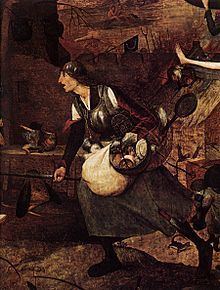Year c. 1562 Period Northern Renaissance | Created 1562 Genre History painting | |
 | ||
Dimensions 115 cm × 161 cm (45 in × 63 in) Pieter Bruegel the Elder artwork The Triumph of Death, The Peasant Dance, The Tower of Babel, The Return of the Herd, The Census at Bethlehem | ||
Dulle Griet (anglicized as Dull Gret), also known as Mad Meg, is a figure of Flemish folklore who is the subject of a 1562 oil-on-panel by Flemish renaissance artist Pieter Bruegel the Elder. The painting depicts a virago, Dulle Griet, who leads an army of women to pillage Hell, and is currently held and exhibited at the Museum Mayer van den Bergh in Antwerp.
Contents
History and description
The signature and the date on this painting are illegible, but its close compositional and stylistic similarity to The Fall of the Rebel Angels and The Triumph of Death, makes it likely that it was painted in about 1562 and destined for a series. Like those pictures, Dulle Griet owes much to Hieronymus Bosch.
Bruegel's earliest biographer, Karel van Mander, writing in 1604, described the painting as "Dulle Griet, who is looking at the mouth of Hell". It came into the collections of Rudolf II, Holy Roman Emperor, then was looted by the Swedish troops in 1648, and reappeared in Stockholm in 1800. Art collector Fritz Mayer van den Bergh discovered it in 1897 at an auction in Cologne, where he bought it for a minimal sum, discovering its actual author a few days later.
Griet was a disparaging name given to any bad-tempered, shrewish woman. Her mission refers to the Flemish proverb:
She could plunder in front of hell and return unscathed.
Bruegel is thus making fun of noisy, aggressive women. At the same time he castigates the sin of covetousness: although already burdened down with possessions, Griet and her grotesque companions are prepared to storm the mouth of Hell itself in their search for more.
Dulle Griet appears as a character in Caryl Churchill's play Top Girls (1982), where she recounts her invasion of Hell: "I'd had enough, I was mad, I hate the bastards. I come out my front door that morning and shout till my neighbors come out and I said, 'Come on, we're going where the evil come from and pay the bastards out.'" (Churchill, 28).
Details
While her female followers loot a house, Griet advances towards the mouth of Hell through a landscape populated by Boschian monsters.see detailed images They represent the sins that are punished there. Griet wears male armour — a breastplate, a mailed glove and a metal cap; her military costume is parodied by the monster in a helmet beside her, who pulls up a drawbridge. A knife hangs from her side, while in her right she carries a sword, which may refer to the saying: "He could go to Hell with a sword in his hand." A book of proverbs published in Antwerp in 1568 contains a saying which is very close in spirit to Bruegel's painting:
One woman makes a din, two women a lot of trouble, three an annual market, four a quarrel, five an army, and against six the Devil himself has no weapon.
Painting materials
The pigment analysis was conducted by the scientists at the Ghent University. Bruegel used the cheap smalt for the robe of the central figure of Mad Meg instead of the more expensive ultramarine together with vermilion and copper resinate.
